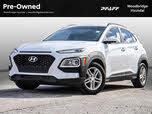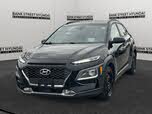2020 Hyundai Kona vs 2021 Lexus GX
Overview | ||
MSRP | $20,300 | $53,450 |
Average price | $21,560 | $61,888 |
Listings | ||
Ratings & Reviews | ||
User reviews | ||
Expert reviews | 6.8 out of 10Read full review | 5.3 out of 10Read full review |
Pros & cons | Pros
| |
Summary | The Hyundai Kona subcompact SUV is one of the smallest cars you can buy with all-wheel drive. It competes in a class of four-door hatchbacks with the lifted suspensions and higher driving positions that crossover buyers want—and with the same generous list of convenience and safety features that come on larger crossovers. We last tested the Kona when it came out for 2018, but a new trim level and more standard driver assists are the major changes for 2020. For what Hyundai charges, the Kona is cramped and the interior disappoints, yet exterior style and on-road performance are spectacular. | ost modern SUVs are really car-based crossovers—lifted station wagons, or minivans without the sliding doors. That’s not the case with the 2021 Lexus GX 460. Like the mythical Loch Ness Monster, the GX is a creature that time forgot. It’s one of the last SUVs with truck-like body-on-frame construction and true off-road capability. That’s because the GX is actually a rebadged Toyota Land Cruiser Prado (a smaller version of the iconic Toyota Land Cruiser not sold in North America), and is related to the Toyota 4Runner. It’s also genuinely old: the current generation dates back to the 2010 model year, and Lexus has kept it in production with some updates of styling and tech over the years. That makes the GX a fairly odd proposition on the new-car market. It has the off-road capability, not as a lifestyle statement, but because that’s what was still expected of SUVs when it was launched. The GX sits between the RX and LX in the Lexus lineup but has little direct competition. Its only real rival is the much newer Land Rover Discovery. For the 2021 model year, the GX gets some minor updates. Lexus continues to offer only the GX 460 model, with a single powertrain option, a standard four-wheel drive (4WD) drivetrain, and two pricing levels: base, or the Executive package. |
Video | No video found | |
Popular Features & Specs | ||
Engine | 2.0L 147 hp I4 | 4.6L 301 hp V8 |
Drive Train | FWD | AWD |
Seating Capacity | 5 | 7 |
Horsepower | 147 hp @ 6200 rpm | 301 hp @ 5500 rpm |
MPG City | 27 | 15 |
MPG Highway | 33 | 19 |
Engine | ||
Engine Name | 2.0L 147 hp I4 | 4.6L 301 hp V8 |
Torque | 132 lb-ft @ 4500 rpm | 329 lb-ft @ 3500 rpm |
Horsepower | 147 hp @ 6200 rpm | 301 hp @ 5500 rpm |
Drivetrain | FWD | AWD |
Fuel Economy | ||
MPG City | 27 | 15 |
MPG Highway | 33 | 19 |
Interior | ||
Seating Capacity | 5 | 7 |
Key Features | ||
Sunroof/Moonroof | Optional | |
Safety | ||
Front Crash Overall | 5 | |
Side Crash Overall | 5 | |
Dimensions & Capacity | ||
Cargo Space | 19.2 cu ft | 11.6 cu ft |
Curb Weight | 2890 lbs | 5130 lbs |
Height | 61.0 in | 74.2 in |
Length | 164.0 in | 192.1 in |
Width | 70.9 in | 74.2 in |
Wheelbase | 102.4 in | 109.8 in |
Maximum Payload | 1089 lbs | 1315 lbs |
Number of doors | 4 | 4 |
Maximum Towing Capacity | 6500 lbs | |
The 2020 Hyundai Kona was a standout in its segment, offering a sleek, sporty, and dramatic exterior that belied its status as a mass-market economy car. Despite being shorter than its competitors, the Kona's design was visually stimulating, with tiered lighting, a tall grille, and matte plastic trim that made it appear taller and wider. The car's exterior was further enhanced by slim LED running lamps, optional fog lights, and fender creases that directed attention to the thin taillights. The Kona's two-tone alloy wheels, sloping roof, and ground-hugging stance contributed to its premium vibe, making it a visually appealing choice in its class.
In contrast, the 2021 Lexus GX retained a more traditional SUV look, with a design that had evolved over a decade. The GX featured the Lexus trademark spindle grille and triple-beam LED headlights, giving it a tough, aggressive appearance. While the exterior styling was kept up to date, the interior felt dated, with wood trim that resembled molded plastic and an abundance of actual plastic. Despite these shortcomings, the GX's exterior remained distinctive, appealing to SUV shoppers looking for a classic design.
The 2020 Hyundai Kona surprised many with its impressive powertrain and chassis. Its 1.6-litre turbocharged inline-four engine delivered 175 horsepower and 195 pound-feet of torque, outperforming most competitors in its segment. The 7-speed dual-clutch transmission provided strong acceleration and confidence in various driving conditions. The Kona's handling was commendable, with fast and direct steering, a tight suspension, and wide tires offering steady grip. However, the ride was stiffer, and the cabin was noisier compared to more refined competitors. Fuel efficiency was average, with the Kona 1.6T AWD rated at 9.0 L/100 km city and 8.0 highway.
The 2021 Lexus GX, on the other hand, featured a 4.6-litre V8 engine producing 301 horsepower and 329 lb-ft of torque, paired with a six-speed automatic transmission. While the V8 provided ample power for initial acceleration, the GX's weight made higher-speed maneuvers challenging. The ride quality was typical of a body-on-frame vehicle, with low grip and body roll in corners. However, the GX excelled in off-road capability, with a Torsen centre differential, low-range 4WD, and features like Crawl Control and Multi-Terrain Select. The GX's towing capacity was 2,948 kilograms, but its on-road performance lagged behind more modern SUVs.
The 2020 Hyundai Kona struggled with interior space, offering seating for four and limited cargo capacity. With 544 litres of cargo space and 1,296 litres with the rear seats folded, it fell short compared to competitors. The Kona's controls were user-friendly, and the infotainment system was simple and fast, but its utility was limited, making it more akin to a small hatchback than a true crossover.
The 2021 Lexus GX's interior reflected its age, with limited legroom and an awkward steering wheel position. The dashboard shape and boxy profile provided excellent visibility, but forward visibility was hindered by the tall hood. The GX offered three rows of seating for seven, but the third row was best suited for children. Cargo space was limited, with 1,833 litres available with the second and third rows folded. The GX's interior was functional but lacked the spaciousness and modernity of newer SUVs.
The 2020 Hyundai Kona came well-equipped with standard features, including a 7-inch touchscreen with Apple CarPlay and Android Auto, Bluetooth, and heated front seats. Higher trims offered a sunroof, adaptive cruise control, and an 8-inch touchscreen with navigation. The Kona's technology package was impressive for its class, providing a good balance of features and usability.
In contrast, the 2021 Lexus GX was light on tech features, lacking Apple CarPlay and Android Auto compatibility. The standard infotainment system had outdated graphics and limited functionality. However, the GX included analog controls for most functions, offering a straightforward interface. The 17-speaker Mark Levinson audio system was a highlight, but overall, the GX's tech offerings were underwhelming for a luxury SUV.
The 2020 Hyundai Kona received high safety ratings, with five out of five stars from the NHTSA and a 2020 Top Safety Pick from the IIHS. It came standard with forward emergency braking, lane-keep assist, and a driver attention monitor. However, it lacked front knee airbags and rear side airbags, and pedestrian detection was only available on the Ultimate trim.
The 2021 Lexus GX had not been rated by the NHTSA or IIHS, but it included the Lexus Safety System+ as standard, featuring a pre-collision system, automatic emergency braking, and adaptive cruise control. Blind-spot monitoring and rear cross-traffic alert were also standard. However, the GX missed some safety features found in other Lexus models, such as traffic-sign recognition and Lane Tracing Assist.
CarGurus highlights

According to CarGurus experts, the overall rating for the 2020 Hyundai Kona is 6.8 out of 10, while the 2021 Lexus GX scores 5.3 out of 10. Based on these ratings, the 2020 Hyundai Kona is the recommended choice, offering a better balance of performance, technology, and safety features for the price.
Choose the 2020 Hyundai Kona if:
Shop Now- You prioritize a sleek, sporty exterior design with a premium vibe.
- You value a powerful and efficient turbocharged engine with excellent handling.
- You want a well-equipped vehicle with modern tech features and high safety ratings.
Choose the 2021 Lexus GX if:
Shop Now- You need a traditional SUV with exceptional off-road capabilities.
- You prefer a classic, aggressive exterior design with a distinctive look.
- You require a vehicle with a high towing capacity and robust build quality.

By: CarGurus + AI
At CarGurus, our team of experienced automotive writers remain at the heart of our content operation, conducting hands-on car tests and writing insightful guides that are backed by years of industry experience. To complement this, we are harnessing AI to make our content offering more diverse and more helpful to shoppers than ever. To achieve this, our AI systems are based exclusively on CarGurus content, ratings and data, so that what we produce is both unique to CarGurus, and uniquely helpful to car shoppers.
























